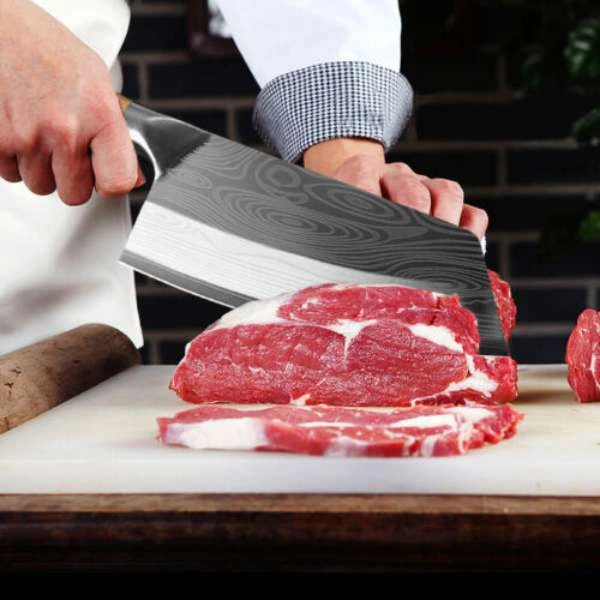Choosing the Right Knife for Meat Prep
The right knife is crucial when preparing meat. A good knife not only improves your efficiency in the kitchen, but it also improves the quality of your cuts. In this guide, we’ll discuss the most important knives for meat prep so you’re well prepared for your culinary adventures.
1. Chef’s Knife: A Kitchen Workhorse
The chef’s knife is the backbone of any kitchen. They have a wide blade, usually 8-10 inches long, which is plenty for a variety of tasks, from slicing and dicing to mincing. This knife is perfect for cutting raw or cooked meat, trimming fat and cutting steaks. Investing in a quality chef’s knife can really elevate your cooking experience.
2. Boning Knife: Precision Made Easy
Bone knives feature a thin, flexible blade, usually 5-7 inches (12-18 cm) long, that is specifically designed for removing bones from meat and fish. Its flexibility allows it to easily navigate around bones, ensuring you get the most meat out of your cut. Whether you’re deboning chicken thighs or filleting fish, a boning knife is a must-have for precision and control.
3. Carving Knife: Perfect for Cutting
When it comes to serving up a perfectly roasted turkey or prime rib, the carving knife is your best friend. This knife typically features a long, narrow blade (8-15 inches) that allows for smooth, even slices. It’s the perfect design to present beautiful cuts, making it perfect for banquets and special occasions.
4. Carving Knife: For Thin Slices
Like a carving knife, a carving knife is usually long and designed for cutting thin slices of cooked meats, such as brisket or smoked ribs. Many carving knives feature a Granton edge, a depression along the blade that reduces friction. This allows you to cut smoothly through tender meats without tearing, ensuring every slice is perfect.
5. Cleaver
Power Meets Versatility For more difficult cuts, a cleaver is a must. With a thick, heavy blade, it is designed to slice through bones and tough meat. Although a cleaver is primarily a tool for cutting meat, it is also useful for crushing garlic and chopping vegetables. This is a great all-purpose tool that every meat lover should have.
6. Utility Knife: Your Everyday Companion
Utility knives are smaller than chef knives, usually about 6 inches long. They’re great for tasks that don’t require a large knife and require precision. Whether you’re trimming fat from a roast or cutting small pieces of meat, a cutter knife gives you the versatility you need for everyday cooking.
7. Meat tenderizer:
Tenderize tough cuts Even if you don’t have a knife, a meat tenderizer or meat tenderizer is essential for breaking up tough cuts. Pounding meat to an even thickness not only ensures it cooks evenly, but also enhances flavor and tenderness. It’s a simple but effective way to ensure your food turns out perfect every time.
8. Knife Maintenance: Keep Them Sharp
To get the most out of your knives, proper maintenance is key. Regularly sharpening your knives with a whetstone or honing steel ensures they perform at their best. Always hand wash your knives and dry them thoroughly to prevent rust and damage. A well-maintained knife is safer and more efficient.
Conclusion
Choosing the right knife for meat preparation is essential for achieving excellent results in your cooking. By understanding the various types of knives and their specific functions, you’ll be better equipped to tackle any meat preparation task. Investing in quality knives and taking care of them will not only enhance your culinary skills but also make cooking more enjoyable. Happy cooking!



